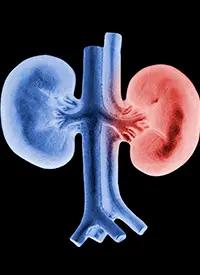News
Article
Durvalumab Plus Guadecitabine Shows PFS Benefit in Cohort of Patients With ccRCC
Author(s):
Durvalumab in combination with guadecitabine was tolerable and led to a PFS benefit in patients with checkpoint inhibitor-naive ccRCC.
Durvalumab Plus Guadecitabine in ccRCC
| Image Credit: © Nitiphol - stock.adobe.com

Durvalumab (Imfinzi) in combination with the novel hypomethylating agent guadecitabine (SGI-110) was tolerable and displayed an encouraging progression-free survival (PFS) signal in patients with advanced clear cell renal cell carcinoma (ccRCC), according to findings from the phase 1b/2 BTCRC-GU16-043 trial (NCT03308396) published in Nature Communications.
Although phase 2 of the study did not meet its primary end point, with durvalumab plus guadecitabine yielding an objective response rate (ORR) of 22% among checkpoint inhibitor-naive patients (cohort 1; n = 36), the median PFS in this cohort was 14.26 months (95% CI, 7.13- 24.5). Comparatively, the ORR was 7% and the median PFS was 3.91 months (95% CI, 3.09- 9.1) in those who previously received a checkpoint inhibitor (cohort 2; n = 15) at the median follow-up of 20 months. The median overall survival (OS) was not reached in either cohort.
“Epigenetic modulation has demonstrated clinical benefit and been [used] extensively in hematologic malignancies; however, its use in solid tumors is being explored increasingly,” study authors wrote. “To our knowledge, this study is one of few evaluating the safety and efficacy of a hypomethylating agent with a checkpoint inhibitor in advanced solid tumors, specifically in RCC….We believe the observed median PFS in Cohort 1 deserves further validation in a randomized clinical trial.”
BTCRC-GU16-043 was a multicenter, single-arm study that enrolled patients with metastatic ccRCC of pure or mixed histology. Eligible patients were at least 18 years old and had at least 1 lesion measurable by RECIST 1.1, an ECOG performance status of 1 or less, and a life expectancy of at least 12 weeks, as well as adequate bone marrow, renal, and hepatic function. Those with a concurrent active infection requiring systemic therapy, another ongoing primary active malignancy within the last 5 years, or an active inflammatory or autoimmune disease were excluded from the trial; prior allogenic organ transplant was also not permitted. Central nervous system metastases were permitted only if they were adequately treated with at least 4 weeks of imaging stability.
Subcutaneous guadecitabine was given at a starting dose of 60 mg/m2 on days 1 to 5 with de-escalation to 45 mg/m2 in the instance of a dose-limiting toxicity (DLT). All patients received intravenous durvalumab 1500 mg on day 8.
The primary end point in phase 1b was safety by DLTs and identifying the recommended phase 2 dose of guadecitabine in combination with durvalumab. ORR per RECIST 1.1 in cohort 1 was the primary end point in phase 2. Secondary end points included 2-year OS, 12-month PFS, duration of response (DOR), and ORR in cohort 2.
The baseline patient characteristics were well-balanced between cohort 1 and 2; the median age was 68 years (range, 40-85) compared with 65 years (range, 46-93), respectively. Most patients in both cohorts were male (69% vs 73%) and White (92% vs 100%); patients had IMDC intermediate risk disease (94% vs 87%), pure ccRCC (81% vs 67%), and did not have sarcomatoid histology (64% vs 60%). Forty-two percent and 100% of patients in each cohort, respectively, received prior therapy.
Additional findings showed that 1 patient in cohort 1 achieved a complete response and 16 patients (44%) experienced a best response of stable disease lasting for a minimum of 6 months. In cohort 2, 1 patient experienced a partial response and 9 patients (60%) achieved stable disease. Overall, the median time to response was 1.8 months (95% CI, 1.6-2.1) and the median DOR was 7 months (95% CI, 3.2-15.6). In terms of survival in cohorts 1 and 2, 1-year OS rates were 92.9% and 78.0%, respectively, and the 2-year rates were 85.0% and 62.4%, respectively.
In the safety population (n = 57), any-grade treatment-related adverse effects (AEs) due to either guadecitabine or durvalumab occurred at a rate of 35.4%. The most common any-grade AEs included neutropenia (54.4%), fatigue (50.9%), and decreased white blood cell count (43.9%). Dose delays due to AEs occurred at a rate of 60%, and 16% of patients needed corticosteroids for the treatment of immune-related AEs (irAEs). Common any-grade irAEs included dyspnea (28.1%), diarrhea (22.8%), and increased lipase (19.3%).
“Our study had several limitations, including small sample size in both cohorts, single-arm design, and relatively slow accrual,” study authors wrote. “In conclusion, the combination of durvalumab and guadecitabine has an acceptable toxicity profile and promising activity especially in [patients with] checkpoint inhibitor-naive [disease] with advanced ccRCC as first and subsequent lines of therapy. It could be further tested in patient populations where TKI and immunotherapy [agents] are not well tolerated and can cause early treatment discontinuation.”
Reference
Zakharia Y, Singer EA, Acharyya S, et al. Durvalumab and guadecitabine in advanced clear cell renal cell carcinoma: results from the phase Ib/II study BTCRC-GU16-043. Nat Commun. 2024;15(1):972. doi:10.1038/s41467-024-45216-z








